Samurai sword glossary: categorized terms and definitions
This glossary introduces key terms used in the world of Japanese swords, categorized for easier understanding. From blade geometry to tang construction and symbolic fittings, each section brings clarity to a vital part of samurai sword culture.
Table of Contents
- Blade & Edge Features
- Blade Geometry & Structure
- General Terminology
- Historical & Stylistic Terms
- Mountings & Fittings
- Sword Types & Classifications
- Tang & Signature Features
- Use & Performance
Blade & Edge Features
- ashi leg(足)
- thin line that runs across the temper line (hamon) to the cutting edge (ha). hamonha
- bōshi(帽子)
- temper line (hamon) of the blade point (kissaki). (kissaki) (hamon)
- chōji midare clove disorder(丁子乱れ)
- an irregular hamon pattern resembling cloves, with a round upper part and a narrow constricted lower part.
- fukura(脹)
- the cutting edge (ha) of the blade point (kissaki). ( kissaki ) ( ha )
- gunome(互目)
- a wave-like outline of the temper line (hamon) made up of similarly sized semicircles. hamon
- ha edge边缘(刃)
- the tempered cutting edge of a blade. The side opposite the mune. Also called hasaki or yaiba. hasakiyaiba
- hajimi(刃染)
- misty spots in the temper line (hamon) resulting from repeated grinding or faulty tempering. ( hamon )
- hamachi/hamati(刃区)
- notch in the cutting edge (ha), dividing the blade proper from the tang (nakago). ( ha ) ( nakago )
- hamon(刃文)
- border between the tempered part of the ha (cutting edge) and the untempered part of the rest of the sword; the temper-line. ha;
- hataraki activity, workings 活动,工作(働)
- patterns and shapes such as lines, streaks, dots and hazy reflections that appear in addition to the grain pattern (jihada) and the temper line (hamon) on the surface of the steel and are a result of sword polishing. jihada hamon
- hiraji(平地)
- curved surface between ridge (shinogi) and temper line (hamon). Also called hira. If polished, the hiraji appears blue-black. ( shinogi ) ( hamon )hira
- hitatsura(皆焼)
- temper line (hamon) with tempering marks visible around the ridge and near the edge of the blade. ( hamon )
- ichimai bōshi(一枚帽子)
- a fully tempered point area (kissaki) because the hamon turns back before reaching the point. ( kissaki )hamon
- iori(庵)
- top ridge of the back edge (mune), the back ridge. ( mune )
- ji(地)
- area between the ridge (shinogi) and the hamon. shinogihamon
- kaeri(返り)
- part of the temper line (hamon) that extends from the tip of the bōshi to the back edge (mune). bōshi( mune )( hamon )
- kasane(重ね)
- blade thickness measured across the back edge (mune). (see also motokasane and sakikasane) ( mune ) motokasanesakikasane
- katana(刀)
- curved sword with a blade length (nagasa) longer than 60 cm (24 in). Worn thrust through the belt with the blade edge (ha) facing upward. It superseded the older tachi () starting in the Muromachi period, after 1392.Also a (now rare) general term for single-edged blades, see tō. (nagasa) 60 24 (ha) 1392 tō
- ken(剣)
- a double-edged blade (sword/dagger) of any size or shape. /
- kinsuji gold line(金筋)
- a double-edged blade (sword/dagger) of any size or shape. /
- ko-maru small circle(小丸)
- a bōshi that runs parallel to the cutting edge of the point area (kissaki) and then forms a small circle as it turns back towards the back edge (mune). Kissakibōshimune
- ko-shinogi(小鎬)
- diagonal line that separates the point of a blade (kissaki) from the shinogiji and extends the ridge (shinogi) to the back edge (mune) in the kissaki area. (Kissaki) shinogiji (shinogi) Kissaki (mune)
- midareba(乱刃)
- an irregular temper line (hamon). (also see suguha) hamonsuguha
- midare komi(乱込み)
- irregular temper line (midareba) that continues into the point (kissaki). ( midareba ) ( Kissaki )
- mihaba blade width刀片宽度(身幅)
- distance from the blade edge (ha) to the back edge (mune). (also see sakihaba and motohaba) ( ha ) ( mune ) sakihabamotohaba
- mune(棟)
- back edge of a blade, i.e., the side opposite the cutting edge (ha). ( ha )
- munemachi/munemati(棟区)
- notch in the back edge (mune), dividing the blade proper from the tang (nakago). ( mune ) ( nakago )
- nagasa length(長さ)
- blade length measured from the point to the back edge notch (munemachi). munemachi
- notare(湾れ)
- gently waving temper line (hamon). ( hamon )
- sansaku bōshi(三作帽子)
- bōshi seen in the works of the three swordsmiths: Osafune Nagamitsu, Kagemitsu and Sanenaga: hamon continues as straight line inside the point (kissaki) area running towards the tip of the blade. Just before reaching the tip, the bōshi turns in a small circle (ko-maru) a short distance to the back edge (mune) remaining inside the kissaki. bōshi Osafune NagamitsuKagemitsu Sanenaga hamon ( kisaki ) bōshi Kissaki ( mune ) ( ko-maru )
- shinogi ridge脊(鎬)
- ridge running along the side of the sword, generally closer to the back (mune) than the cutting edge (ha). ha mune
- shinogiji(鎬地)
- flat surface between ridge (shinogi) and back edge (mune).
- shinogi-zukuri(鎬造)
- a curved blade with yokote and a ridge (shinogi) quite close to the back edge (mune). Also known as hon-zukuri (, main style). ( shinogi ) ( mune ) hon-zukuri
- shōbu-zukuri(菖蒲造)
- a curved blade without yokote and a ridge (shinogi) quite close to the back edge (mune); basically shinogi-zukuri without yokote. ( shinogi ) ( mune );shinogi-zukuri
- sori curvature曲率(反り)
- curvature of the sword measured as the greatest perpendicular distance between the back edge (mune) and the chord connecting the back edge notch (munemachi) with the point of the blade. ( mune ) ( munemachi )
- suguha(直刃)
- straight temper line (hamon). (also see midareba) hamon
- sunagashi stream of sand(砂流)
- marks in the temper line (hamon) that resemble the pattern left behind by a broom sweeping over sand. hamon
- tachi(太刀)
- curved sword with a blade length (nagasa) longer than 60 cm (24 in) and typically 70–80 cm (28–31 in). Worn slung across the hip with the blade edge (ha) facing down. Primarily produced in the kotō period. Not to be confused with the tachi (). (nagasa) 60 24 70–80 28–31 (ha)
- tō(刀)
- single-edged blades (saber/knife) of any size or shape. /
- tobiyaki(飛焼)
- a tempered spot within the ji not connected to the main temper line (hamon). ji ( hamon )
- tōken(刀剣)
- umbrella term for all single- and double-edged blades of any size and shape.
- tsuba(鍔 or 鐔)
- sword guard; generally a round metal plate with a central wedge shaped hole for the blade and if needed up to two smaller holes for the kozuka or kōgai ; kozukakōgai
- tsurugi(剣)
- symmetrical double-edged thrusting weapon popular in the Nara and early Heian period.[56][57] Also a (now rare) general term for double-edged blades, see ken. ken
- uchi-zori(內反)
- curvature (sori) of the blade with a slight curve toward the cutting edge (ha). ( sori ) ( ha )
- yakitsume(烧诘)
- without turn-back (kaeri); a bōshi that continues directly to the back edge (mune). ( kaeri ); bōshi ( mune )
- yō leaves叶子(葉)
- activity (hataraki) in the temper line (hamon) that resembles fallen leaves or tiny footprints. After the late Sengoku period (late 16th century) referred to as nioi kuzure. ( hamon ) ( hataraki ) 16nioi kuzure
- yoroi tōshi straight through armour 直穿盔甲(鎧通し)
- dagger used for cutting through armour. Their length (nagasa) was originally fixed at 9.5 sun (29 cm), a value that was later reduced to 7.5 sun (23 cm). Originally worn thrust vertically through the back of the belt; later carried at the ride side with the hilt to the front and the edge facing up. nagasa 9.5 sun29 7.5 sun23 ;
Blade Geometry & Structure
- bokutō(木刀)
- an authentically shaped wooden (practice) sword (or other bladed weapon).
- gomabashi(護摩箸)
- pair of parallel grooves running partway up the blade resembling chopsticks.
- jūka chōji double clove双丁香(重化丁子)
- multiple overlapping clove shaped chōji midare patterns. chōji midare
- kissaki(切先)
- fan-shaped point of the blade; separated from the body of the sword by the yokote. ;
- naginata(薙刀, 長刀)
- pole weapon wielded in large sweeping strokes. Typically with a wide blade, long tang and without yokote. It often has a distinctive carved groove. Also called chōtō. chōtō
- sugata shape形状(姿)
- the overall shape of the blade.
General Terminology
- chikei(地景)
- black gleaming lines of nie that appear in the ji. nie
- chirimen-hada crape grain pattern 绉纹图案(縮緬肌)
- distinctly visible mokume-hada with a clearer steel than in similar but coarser patterns.
- chōken long sword(長剣)
- Commonly used as a calque for the broadest definition of (European) long swords.
- daishō large (and) small(大小)
- in context any pair of Japanese swords of differing lengths (daitō and shōtō) worn together. daitōshōtō
- funbari(踏ん張り)
- tapering of the blade from the base (machi) to the point (kissaki) ( machi ) ( kissaki )
- gassan-hada(月山肌)
- see ayasugi-hada. ayasugi-hada
- goban kaji honorable rotation smiths尊敬的轮值刀匠(御番鍛冶)
- swordsmiths summoned by the retired Emperor Go-Toba to work at his palace in monthly rotations.
- hasaki(刃先)
- see ha.ha
- hira(平)
- see hiraji.hiraji
- hira-zukuri(平造)
- a nearly flat blade without ridge (shinogi) or yokote. shinogi
- hon-zukuri main style(本造)
- see shinogi-zukuri.shinogi-zukuri
- ichimonji kaeri(一文字返り)
- a bōshi which turns back in a straight horizontal line with a short kaeri. kaeribōshi
- ikubi-kissaki boar's neck point 野猪颈尖(猪首切先)
- a short, stubby blade point (kissaki) kissaki
- inazuma(稲妻)
- itame-hada(板目肌)
- surface grain pattern (jihada) of scattered irregular ovals resembling wood grain. The small/large grain pattern of this type is called ko-itame-hada/ō-itame-hada. jihada/ ko-itame-hada/ō-itame-hada
- jigane(地鉄)
- generally used to refer to the material of the blade.
- jihada grain, texture纹理(地肌)
- visible surface pattern of the steel resulting from hammering and folding during the construction. (also see masame-hada, mokume-hada, itame-hada and ayasugi-hada) masame-hada mokume-hada itame-hadaayasugi-hada
- ji-nie(地沸え)
- nie that appears in the hiraji. hirajinie
- jūken firearm sword火器剑(銃剣)
- a bayonet.
- kaiken(懐剣)
- a dagger concealed in the clothing.
- kataochi gunome(肩落ち互目)
- a gunome with a straight top and an overall slant. gunome
- kawazuko chōji midare tadpole clove disorder(蛙子丁子乱れ)
- a variation of the chōji midare pattern with the peaks resembling tadpoles. chōji midare
- ko-itame-hada(小板目肌)
- see itame-hada.itame-hada
- ko-mokume-hada(小杢目肌)
- see mokume-hada.mokume-hada
- masame-hada(柾目肌)
- straight surface grain pattern (jihada). jihada
- Masamune juttetsu Ten great disciples of Masamune(正宗十哲)
- ten excellent students of Masamune: Gō Yoshihiro, Norishige, Kaneuji, Kinju, Rai Kunitsugu, Hasebe Kunishige, Osafune Kanemitsu, Chogi, Samonji, Sekishi Naotsuna.
- matsukawa-hada(松皮肌)
- surface grain pattern (jihada) resembling the bark of a pine tree. A type of ō-mokume-hada or ō-itame-hada with thick chikei. Also known as hijiki-hada. jihadaō -mokume-hadaō-itame-hada
- mijikagatana short sword(短刀)
- see tantō.tantō
- mitsukado three corners三个角(三つ角)
- point at which the yokote, shinogi and ko-shinogi meet.
- mokume-hada(杢目肌)
- surface grain pattern (jihada) of small ovals and circles resembling the burl-grain in wood. The small/large grain pattern of this type is called ko-mokume-hada/ō-mokume-hada. jihada / ko-mokume-hada/ō-mokume-hada
- motohaba bottom width底部宽度(元幅)
- blade width (mihaba) at the bottom of the blade (machi). machi mihaba
- motokasane(元重 ね)
- blade thickness (kasane) at the bottom of the blade (machi). ( machi )( kasane )
- nagakatana long sword(長刀)
- any sword with a blade longer than a tantō, particularly exceptionally large ones (e.g. nodachi). Also called chōtō. tantōnodachichōtō
- nakago tang唐(茎)
- unpolished part of a blade that is concealed by the hilt.
- nashiji-hada(梨地肌)
- surface grain pattern (jihada) resembling the flesh of a sliced pear (jap. nashi); i.e. essentially fine dense ko-mokume-hada with surface nie throughout. ( jihada ) (jap. nashi );ko-mokume-hada nie
- nie(沸え)
- small distinct crystalline particles due to martensite, austenite, pearlite or troostite that appear like twinkling stars.
- nihontō Japanese sword(日本刀)
- a curved blade with ridge (shinogi). shinogi
- nioi(匂い)
- indistinguishable crystalline particles due to martensite, austenite, pearlite or troostite that appear together like a wash of stars.
- nioi kuzure(匂い崩)
- see yō.yō
- nodachi field sword野战剑(野太刀)
- very large and heavy sword with lengths (nagasa) up to 120–150 cm (47–59 in) for the use in field battles. Worn across the back. nagasa 120-150 47-59
- ōdachi(大太刀)
- very large sword invented in the 14th century. with lengths (nagasa) of 4–5 ft (1.2–1.5 m). Worn slung from the shoulder. 14 (nagasa) 4–5 (1.2–1.5 m)
- ō-hada(大肌)
- a large grain pattern (jihada). ( jihada )
- ō-itame-hada(大板目肌)
- see itame-hada.itame-hada
- ō-mokume-hada(大杢目肌)
- see mokume-hada.mokume-hada
- ōtachi(大太刀)
- alternative reading of ōdachi.
- sakihaba top width顶部宽度(先幅)
- blade width (mihaba) at the yokote. mihaba
- sakikasan(先重ね)
- blade thickness (kasane) at the yokote. ( kasane )
- saki-zori(先反)
- curvature (sori) of the blade with the center of the curve lying near the point. ( sori )
- Sekigane(責金)
- Metal inserts applied to the hitsu-ana, in order to resize them to a smaller fitting blade or saya implement hisu-ana saya
- sumigane ink iron墨铁(墨鉄)
- plain dark spots on the ji that differ considerably from the surface pattern in both color and grain. ji
- tachi(大刀)
- straight sword (chokutō) produced in ancient times with a blade length (nagasa) longer than 60 cm (24 in). Not to be confused with the tachi (). ( chokutō ) ( nagasa ) 60 24
- tahamagane(玉鋼)
- torii-zori(華表反り)
- curvature (sori) of the blade in which the center of the curve lies roughly in the center of the blade resembling the horizontal bar of torii. ( sori )
- tōsu(刀子)
- an ancient (jokotō) very short knife with blade length (nagasa) of 10 cm (3.9 in) or less. ( jokotō ) ( nagasa ) 10 3.9
- utsuri reflection反射(映り)
- misty reflection on the ji or shinogiji usually made of softer steel. jishinogiji
- yaiba(刃)
- see ha.ha
- yokote(橫手)
- line perpendicular to the ridge (shinogi) which marks off the kissaki from the rest of the blade. shinogi
- yubashiri(湯走)
- spot or spots where nie is concentrated on the ji. nieji
Historical & Stylistic Terms
- ayasugi-hada(綾杉肌)
- regular wavy surface grain pattern (jihada). Also known as gassan-hada after the name of a school which usually produced swords of this type. ()
- chokutō straight sword直刀(直刀)
- a straight sword primarily produced during the ancient period (jokotō). Their definition as tachi () is specifically chronological, as it refers solely to ancient pre- Heian swords, unlike tachi () which refers to later swords. These ancient Japanese swords are also known as jokotō (, ancient sword). jokotōtachitachi jokotō
- gendaitō modern swords(現代刀)
- swords produced after 1876. Also the name for the period in sword history from 1876 to the present day, i.e., the period that succeeded the shinshintō period. 1876 1876
- gokaden Five traditions五种传统(五ヶ伝)
- the five basic styles of swords which during the kotō period were associated with the provinces: Yamashiro, Yamato, Bizen, Sagami/Sōshū and Mino. /
- jōkotō ancient sword(上古刀)
- a sword produced before the mid-Heian period. Unlike later blades, these are straight swords. The term is also used to refer to the respective period of swordsmanship which was followed by the kotō period.
- kotō old sword(古刀)
- a pre-Edo period sword as opposed to a shintō. The year of transition is generally taken to be 1596. The term is also used to refer to the respective period of swordsmanship where the lower limit is given by the appearance of curved swords in the mid-Heian period. The kotō period succeeded the jokotō period. 1596
- shinshintō new-new sword(新々刀)
- period in sword history characterized by the revival of old sword styles, especially those from the Kamakura period. It follows the shintō period and is generally dated from the late 18th century to about 1876, when the wearing of swords was prohibited. The term is also used to denote swords produced in this period. 18 1876
- shintō new sword(新刀)
- post-Edo period swords produced after the end of the kotō period (after 1596) and before the period of revival of old styles at the end of the 18th century which is known as shinshintō. The term is also used to refer to the respective period of swordsmanship. 1596 18 shinshintō
- tanken short sword(短剣)
- knife or dagger (strictly speaking only the latter) with a length (nagasa) shorter than 30 cm (12 in) and typically about 26 cm (10 in). Usually constructed in flat style (hira-zukuri). (also see tantō, kaiken)[27] Commonly used as a calque for the broadest definition of (European) short swords. nagasa 30 12 26 10 hira-zukuritantō kaiken
- tantō short sword(短刀)
- knife or dagger (strictly speaking only the former) with a length (nagasa) shorter than 30 cm (12 in) and typically about 26 cm (10 in). Usually constructed in flat style (hira-zukuri). Also called mijikagatana. (also see tanken, kaiken) nagasa 30 12 26 10 hira-zukurimijikagatanatankenkaiken
- wakizashi(脇差)
- blades with a length (nagasa) between 30 and 60 cm (12 and 24 in). Shorter of the two swords worn by warriors in the Edo period. nagasa 30 60 12 24
Mountings & Fittings
- hijiki-hada(鹿尾菜肌)
- see matsukawa-hada.matsukawa-hada
- kōgai(笄)
- a skewer for the owner's hair-do, carried in a pocket of the scabbards of katana and wakizashi on the side opposite of the kozuka.
- kogatana(小刀)
- any knife, particularly a small utility knife carried in a pocket of the scabbards of katana and wakizashi.
- kozuka(小柄)
- handle of a small utility knife (kogatana) carried in a pocket of the scabbards of katana and wakizashi on the side opposite of the kōgai. Also used to refer to the whole knife, i.e. hilt plus blade. (kogatana) kōgai
- shin guntō neo-army sword新军刀(新軍刀)
- sword of the Imperial Japanese Army with a metal scabbard (saya) produced from the 1930s to the end of World War II in 1945. saya1945
Sword Types & Classifications
- chōtō long sword(長刀)
- either a nagakatana (due to long blade) or a naginata (due to long handle).
- daitō large sword(大刀)
- any type of Japanese long sword, the larger in a pair of daishō. Commonly a katana.
- nagamaki long wrapping长包裹(長巻)
- a large sword with a usually katana-sized blade and a very long handle of about equal length. Successor design to the ōdachi/nodachi. ōdachi/nodachi
- shōtō small sword(小刀)
- any type of Japanese short sword, the smaller in a pair of daishō. Commonly a wakizashi. wakizashi
Tang & Signature Features
- kōgai hitsu-ana(笄櫃孔)
- Opening or passage in the tsuba for purposes of accommodating some object. Respectively prefixed by kanji for kōgai-, kozuka- or nakago- kōgai-kozuka- nakago-
- koshi-zori(腰反)
- curvature (sori) of the blade with the center of the curve lying near or inside of the tang (nakago). ( sori )( nakago )
- kozuka hitsu-ana(小柄櫃孔)
- Opening or passage in the tsuba for purposes of accommodating some object. Respectively prefixed by kanji for kōgai-, kozuka- or nakago- kōgai-kozuka- nakago-
- Kyōhō Meibutsuchō register of famous products from the Kyōhō era(享保名物帳)
- Register of masterpiece swords (meibutsu) compiled by the Hon'ami family in the Kyōhō era.
- machi(区)
- notches that divide the blade proper from the tang. (also see munemachi and hamachi)
- mei(銘)
- signature, usually engraved on the tang (nakago). nakago
- meibutsu famous product名品(名物)
- swords designated as masterpieces. Sometimes used to refer specifically to swords listed in the Kyōhō Meibutsuchō.
- mekugi(目釘)
- a peg of bamboo or horn which passes through the mekugiana to secure the tang in the hilt.
- mekugiana(目釘孔)
- hole in the tang (nakago) for the retaining peg (mekugi) that secures the tang in the hilt. ( nakago ) ( mekugi )
- nakagojiri(茎尻)
- end of the tang (nakago), i.e., the butt of a blade. ( nakago )
- yasurime(鑢目)
- file marks on the tang (nakago) applied as a kind of additional signature and before engraving the real signature (mei). ( mei ) ( nakago )
Use & Performance
- shinken real sword(真剣)
- a real sword as opposed to unsharpened or wooden practice weapons (bokutou). bokutou
Note: This glossary will continue to expand as new terms are studied and documented. It is intended for both collectors and students of Japanese swords.
Shop katana
Our katana store offers a wide selection of japanese swords — from traditional katanas and anime-inspired designs to fully functional blades — featuring a variety of materials and craftsmanship to suit your preferences.

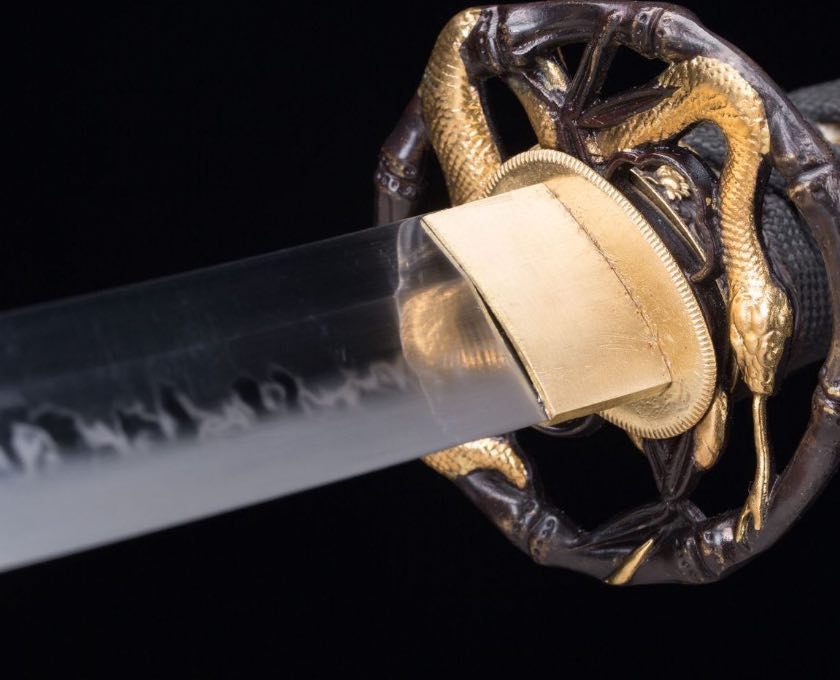
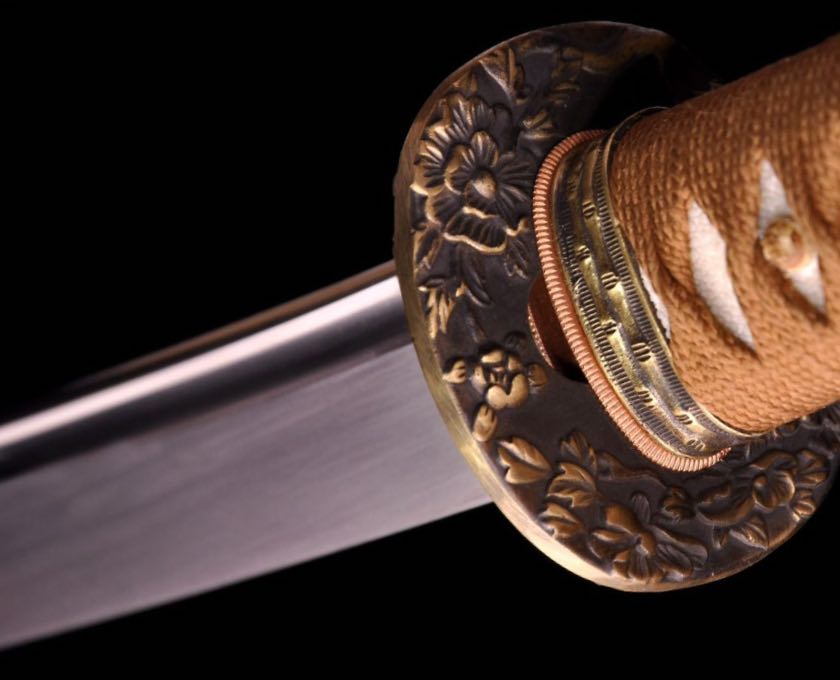

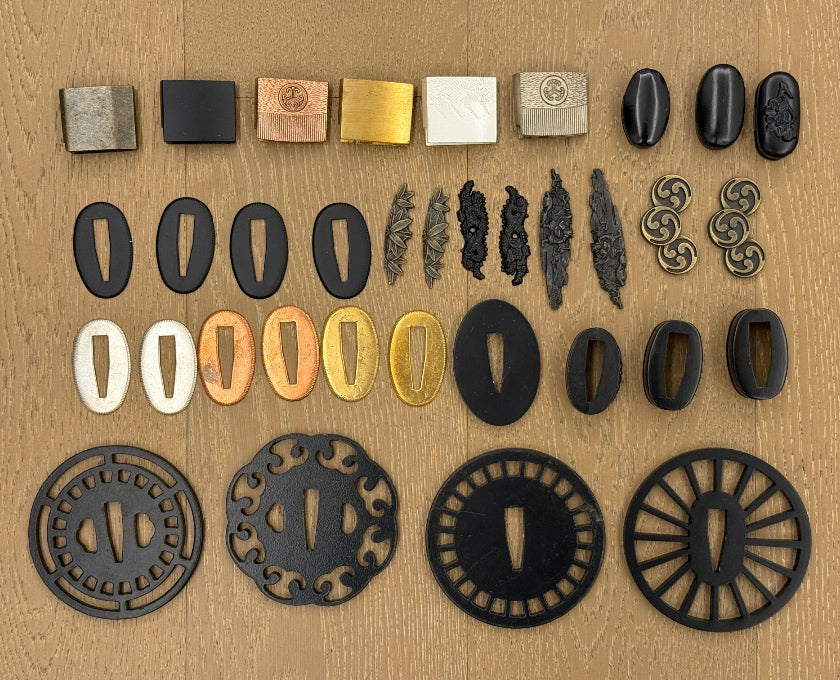
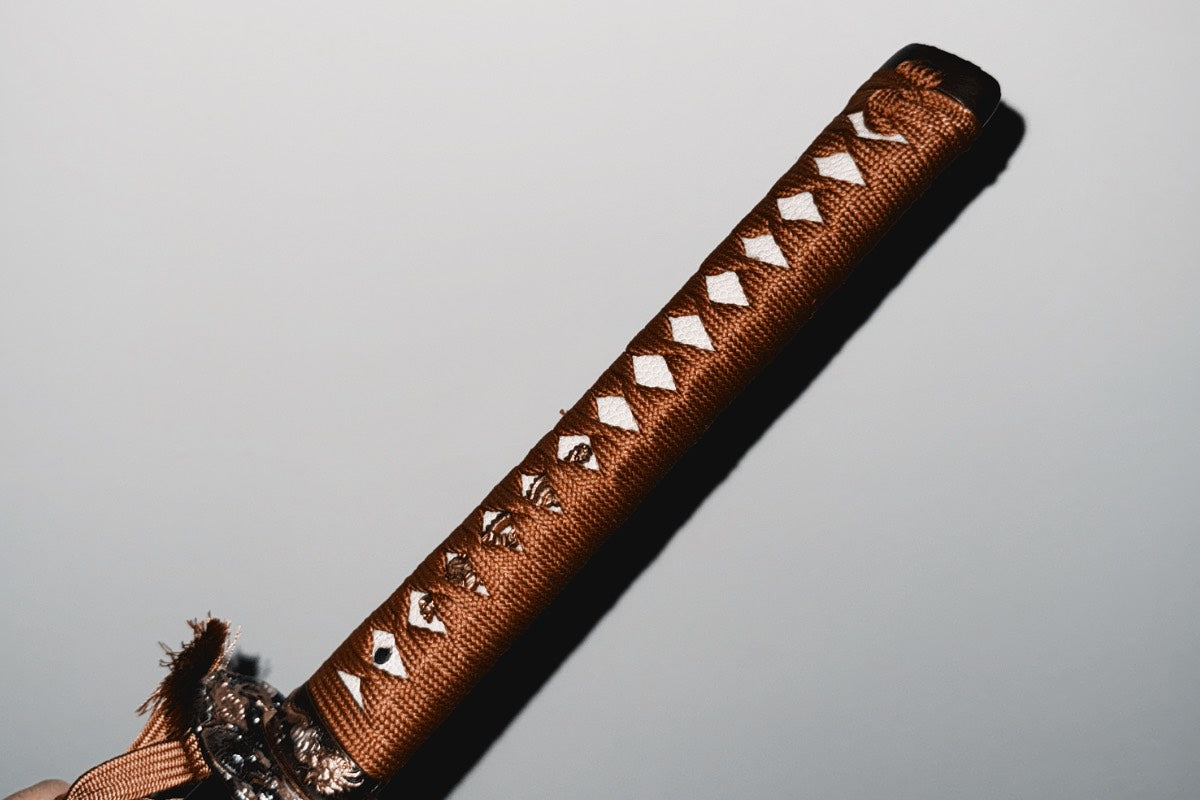
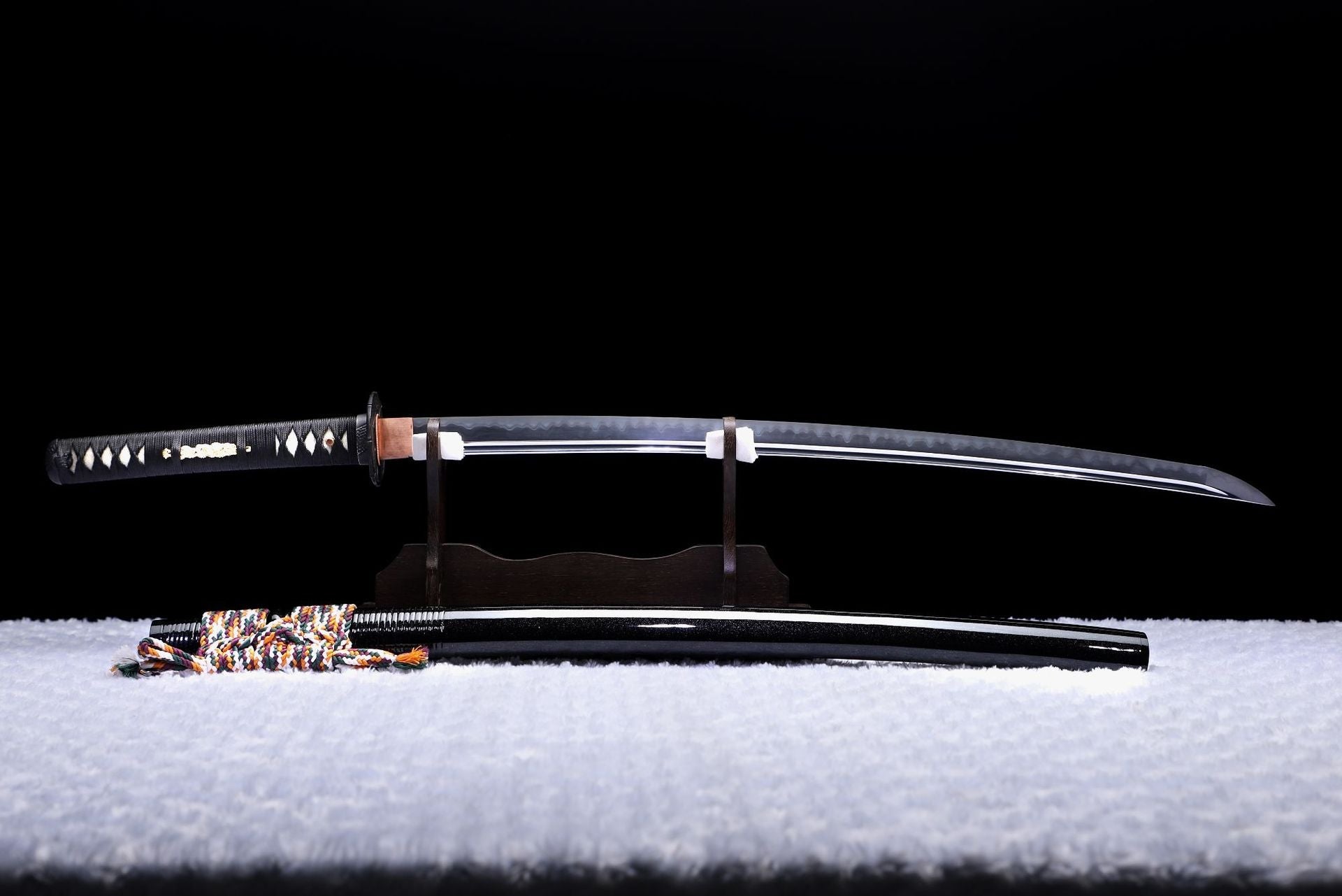
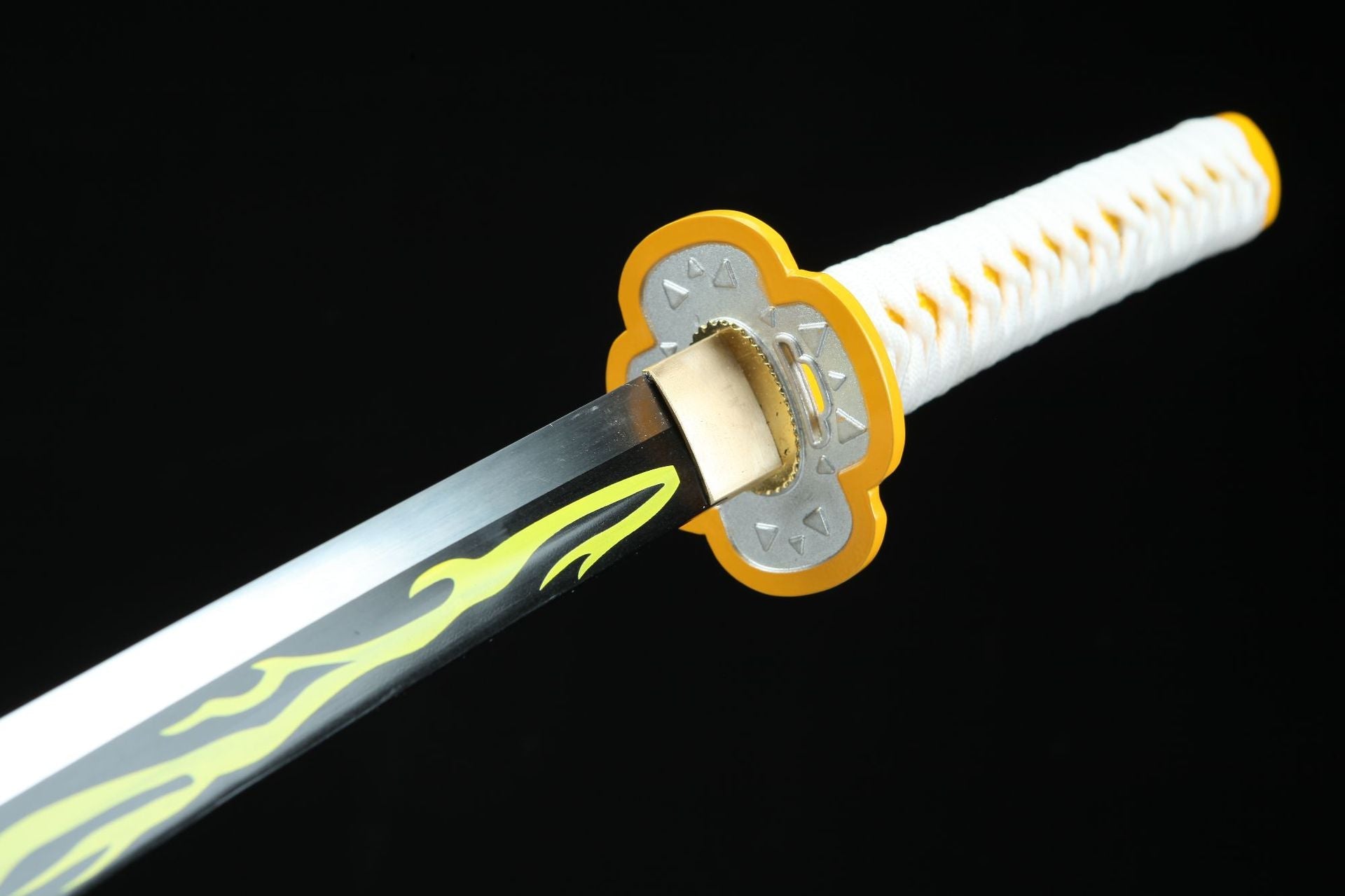
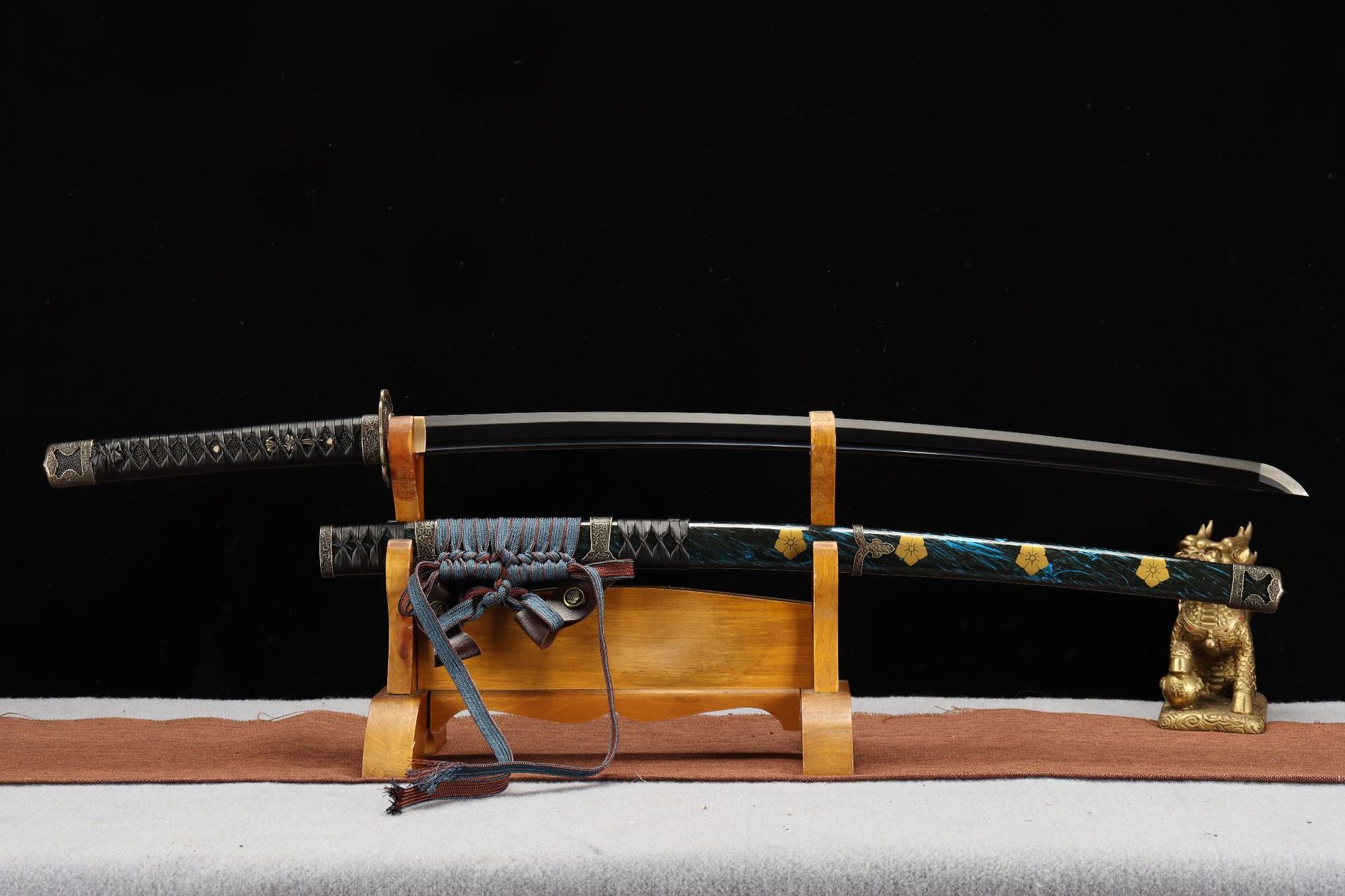
Leave a comment
All comments are moderated before being published.
This site is protected by hCaptcha and the hCaptcha Privacy Policy and Terms of Service apply.